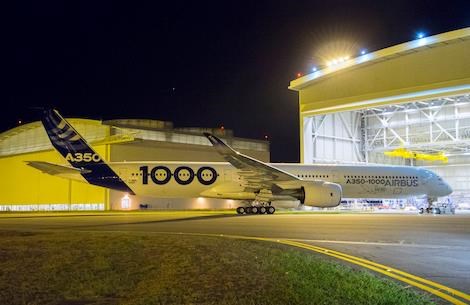PPG Coatings Selected by Airbus for A350-1000 Launch Aircraft
A PPG low-density fuel tank and fuselage sealant provides the three flight-test aircrafts with weight savings compared with traditional sealants and will be used on production A350-1000 airplanes to benefit operators.

MSN059, the first A350-1000 test aircraft, was recently fitted with its engines and will soon undergo a preparatory phase of tests. It is on track for its first flight in the fourth quarter of 2016. Photo by Airbus.
One of three Airbus A350-1000 flight-test aircrafts has been painted in the Airbus livery with a selectively strippable system by PPG that shortens repaint cycle time using Desothane HD 9008 basecoat-clearcoat for high-intensity, long-lasting color. A PPG low-density fuel tank and fuselage sealant provides the three flight-test aircrafts with weight savings compared to traditional sealants and will be used on production A350-1000 airplanes to benefit operators.
For the selectively strippable system, chrome-free Desoprime HS 7049 primer by PPG was applied over the existing base primer and F565 intermediate coating added over it, and then the aircraft was painted with Desothane color basecoat and clearcoat. When it is time for repainting, only the intermediate coating, basecoat and clearcoat will need to be removed for new applications, leaving Desoprime primer and the underlying base primer intact, reducing aircraft downtime by about 30 to 40 percent.
Desothane HD 9008 basecoat-clearcoat has a color-saturated basecoat that achieves opacity with less paint than direct-gloss topcoats and a high-shine clearcoat for exceptional service life.
“PPG is proud that Airbus has chosen advanced PPG paint systems for an aircraft that launches the new A350-1000,” says Daniel Bencun, PPG aerospace coatings segment manager for the Europe, Middle East and Africa region. “Airlines can see the superior aesthetics provided by the PPG basecoat-clearcoat topcoat system and can specify it for their aircraft. They also can select the PPG selectively strippable system to benefit from its cycle time reduction when repainting is needed.”
PR-1782 low-density aircraft fuel tank and fuselage sealant by PPG offers as much as a 30 percent weight saving by volume over traditional sealants used for those applications, affording enhanced aircraft fuel economy. It is qualified by Airbus for all of the aircraft manufacturer’s airframes.
The coatings, sealant and associated products for the A350-1000 aircraft are sourced from PPG facilities in Shildon, England, Gonfreville, France, and Mojave, California, U.S.; and from the Bezon, France, plant operated by PPG joint-venture Sealants Europe.
For information, visit ppgaerospace.com.
Related Content
-
Masking Solutions for Diverse Applications
Global Mask of Barcelona, Spain showcases its solutions at Paint Expo 2024 in Germany.
-
Can You Afford to Not Use Custom Masking?
Are you weighing the costs of a custom masking solution vs. an off-the-shelf solution? Christy Schulthess of Custom Fabricating & Supplies discusses the overall savings that can be realized with custom masking.
-
Top Shop Builds Original Systems for Coating Medical Devices
Engineers at Surgical Coatings in Colorado have been ingeniously developing their own equipment, automation, processes and software since this powder coater’s inception in 1995.










.jpg;maxWidth=300;quality=90)




